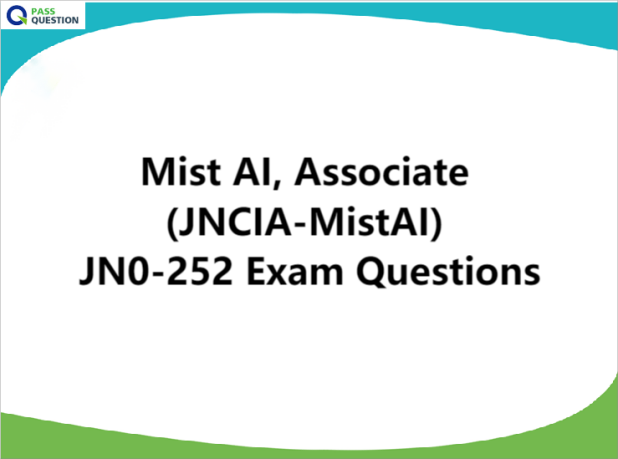Mist AI, Associate (JNCIA-MistAI) JN0-252 Exam Questions
Successfully passing the JN0-252 Mist AI, Associate (JNCIA-MistAI) exam is a testament to your basic understanding of WLAN and Mist AI technology, including its main features and functionality. PassQuestion provides up-to-date and comprehensive Mist AI, Associate (JNCIA-MistAI) JN0-252 Exam Questions, specifically designed to help you fully comprehend the actual exam scenarios. Utilizing these resources will significantly aid in building your confidence, equipping you with the necessary knowledge and skills to successfully navigate through the examination. By diligently working with our Mist AI, Associate (JNCIA-MistAI) JN0-252 Exam Questions, you will be well-prepared and capable of clearing your JNCIA-MistAI JN0-252 exam on the very first attempt.

Mist AI, Associate (JNCIA-MistAI) Exam
The Mist AI track enables you to demonstrate a thorough understanding of WLAN technology in general and the Mist AI features and functionality. JNCIA-MistAI, the associate-level certification in this track, is designed for Wireless LAN networking professionals with introductory knowledge of wireless networking using the Mist AI. The written exam for the certification verifies your basic understanding of WLAN and Mist AI technology, features, and functionality.
This track contains three certifications:
JNCIA-MistAI: Mist AI, Associate. (JN0-251)
JNCIS-MistAI-Wireless: Mist AI Wireless, Specialist. (JN0-451)
JNCIS-MistAI-Wired: Mist AI Wired, Specialist. (JN0-460)
Exam Information
Exam Code: JN0-252
Prerequisite Certification: None
Delivered by Pearson VUE
Exam Length: 90 minutes
Exam Type: 65 multiple-choice questions
Juniper JN0-252 Exam Topics
Juniper Mist Cloud Fundamentals
Identify fundamental concepts about the Juniper Mist cloud-native architecture, including:
● AI concepts
● Machine learning
● Benefits of using cloud-based management
● Juniper Mist cloud capabilities and use cases
Juniper Mist Configuration Basics
Identify the concepts or functionality of Juniper Mist AI accounts, including:
● Creation and management of user accounts
● Capabilities of different account roles
● Juniper Mist Cloud user/account authentication methods
Describe the concepts or functionality of Juniper Mist AI initial configurations, including:
● Factory default configurations and network connection prerequisites
● Device claiming and onboarding
● Creation and management of Juniper Mist organizations and sites
● Template usage
● Labels and policies
Identify the concepts or functionality of Juniper Mist AI advanced configurations, including:
● Subscriptions (Licensing)
● Certificates (Radsec, Mist)
● Auto provisioning
Juniper Mist Network Operations and Management
Identify concepts or functionality of Juniper Mist wireless network management and operations features:
● Benefits and features of Juniper Mist Wi-Fi Assurance
Identify concepts or functionality of Juniper Mist wired network management and operations features:
● Benefits and features of Juniper Mist Wired Assurance
● Benefits and features of Juniper Mist WAN Assurance
Juniper Mist Monitoring and Analytics
Identify the concepts or components of Juniper Mist AI monitoring and analytics, including:
● SLEs
● Packet captures
● Juniper Mist insights
● Alerts
● Audit logs
Marvis Virtual Network Assistant AI
Identify the concepts or functionality of Marvis AI, including:
● Marvis actions (org-level, site-level)
● Marvis queries
Location-based Services
Identify the concepts or components of Location-based Services (LBS), including:
● Juniper Mist vBLE concepts (ie. asset visibility, vBLE engagement)
Juniper Mist Cloud Operations
Identify the concepts or components of Juniper Mist APIs
● RESTful
● Websocket
● Webhook
Identify the options of Juniper Mist support
● Support tickets
● Update information
● Documentation
View Online Mist AI, Associate (JNCIA-MistAI) JN0-252 Free Questions
1. Where can user-defined labels be applied in the Mist UI?
A. A WLAN
B. An Organization
C. A Site
D. A WXLAN Policy
Answer: D
2. At which two levels can labels be created? (Choose two.)
A. Organization-level
B. Switch level
C. Site-level
D. Access Point level
Answer: A, C
Which Mist location-based feature would be used for wayfinding?
A. Wi-Fi 6
B. Asset Visibility
C. vBLE Engagement
D. Wi-Fi Location
Answer: C
4. Which administrator role must you have to view audit logs?
A. Installer
B. Network Admin
C. Super User
D. Observer
Answer: B
5. Which SLE would you use to determine Wi-Fi interference?
A. AP Uptime
B. Roaming
C. Successful Connects
D. Capacity
Answer: D
6. Which statement is correct about Mist SLEs?
A. A Mist classifier is comprised of multiple SLEs.
B. A Mist SLE is comprised of multiple classifiers.
C. A Mist classifier is comprised of a single SLE.
D. A Mist SLE is comprised of a single classifier.
Answer: B
7. Which two statements are correct regarding WXLAN policies? (Choose two.)
A. WLAN templates are used to create site-level policies
B. If policies are defined at both the organization and site level, site-level policies will always be handled first
C. WLAN templates are used to create organization-level policies
D. If policies are defined at both the organization and site level, organization-level policies will always be handled first
Answer: C, D
8. What are two categories that machine learning models are grouped into? (Choose two.)
A. Reinforcement learning
B. Natural Language Processing
C. Supervised learning
D. Vision
Answer: A, C
9. Which two technologies are available to use in LBS? (Choose two.)
A. Gyroscope
B. WLAN
C. GPS
D. Doppler
Answer: B, C
10. The Connectivity category in Marvis Actions displays connectivity failures for which devices?
A. WAN edge and wireless
B. wireless only
C. WAN edge and wired
D. wireless and wired
Answer: D
- TOP 50 Exam Questions
-
Exam
All copyrights reserved 2025 PassQuestion NETWORK CO.,LIMITED. All Rights Reserved.

